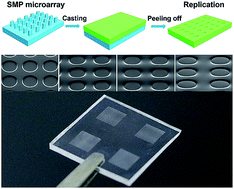Tunable shape memory polymer mold for multiple microarray replications†
Abstract
Microarrays have attracted great interest due to their widespread applications in anti-icing, cell manipulation, and antibioadhesion. However, such arrays are typically fabricated with high-cost and time-consuming lithography techniques. Various kinds of new polymers have been developed to solve this problem. Nevertheless, most of the microarrays fabricated with these materials are usually static, lacking sufficient intelligence and therefore hindering their practical applications. Here, a new strategy is reported that introduces shape memory polymer (SMP) into microarray fabrication. The deformation and recovery of SMP microarrays was investigated, and they show robust controllability and stable surface wettability, as well as a high shape recovery ratio (∼91%) at microscale, even after more than ten cycles of “stretch-recovery” process. In addition, various microarrays with a series of continuously changeable microscales were replicated by using the patterned SMP film as a tunable mold. Specifically, the SMP mold not only shows excellent ability to replicate multiple microarrays with controlled and ordered microstructures via one specific SMP mold, but it also can be applied to various polymers with more than ten replicas. This universal strategy paves an avenue for the broad applications of SMP arrays in cell manipulation, water droplet manipulation and smart dry adhesives.



 Please wait while we load your content...
Please wait while we load your content...